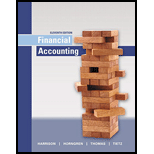
Financial Accounting Plus MyLab Accounting with Pearson eText - Access Card Package (11th Edition)
11th Edition
ISBN: 9780134436135
Author: Walter T. Harrison Jr., Charles T. Horngren, C. William Thomas, Wendy M. Tietz
Publisher: PEARSON
expand_more
expand_more
format_list_bulleted
Question
Chapter 3, Problem 3.19AE
a.
To determine
The amount that is to be reported as revenue for the year 2016 and to explain the way in which revenue principle help in this situation.
b.
To determine
The total expense that is to be reported as expense for the year 2016 and to explain the way in which the accounting principle help in this situation.
c.
To determine
To calculate: The “part a” and “part b” using the cash basis and to explain the way in which the accrual basis differs from cash basis.
d.
To determine
To explain: The statement in which revenues and expenses are reported and to explain the statement in which the cash receipts and cash payments are reported.
Expert Solution & Answer
Want to see the full answer?
Check out a sample textbook solution
Students have asked these similar questions
My problem with solution and accounting question
Provide answer
Shoreline Production Inc. estimated its manufacturing overhead costs for 2023 to be $675,000, based on 225,000 estimated machine hours. The actual machine hours for 2023 were 240,000. The manufacturing overhead account contains debit entries totaling $690,000. Determine whether the manufacturing overhead for 2023 was overallocated or underallocated. (Round your immediate calculations to one decimal place.)
Chapter 3 Solutions
Financial Accounting Plus MyLab Accounting with Pearson eText - Access Card Package (11th Edition)
Ch. 3 - Prob. 1QCCh. 3 - Prob. 2QCCh. 3 - Prob. 3QCCh. 3 - Prob. 4QCCh. 3 - Prob. 5QCCh. 3 - Prob. 6QCCh. 3 - Prob. 7QCCh. 3 - Prob. 8QCCh. 3 - Prob. 9QCCh. 3 - Prob. 10QC
Ch. 3 - Prob. 11QCCh. 3 - Prob. 12QCCh. 3 - Prob. 13QCCh. 3 - Prob. 14QCCh. 3 - Prob. 15QCCh. 3 - Prob. 16QCCh. 3 - Prob. 17QCCh. 3 - Prob. 3.1ECCh. 3 - Prob. 3.1SCh. 3 - Prob. 3.2SCh. 3 - Prob. 3.3SCh. 3 - Prob. 3.4SCh. 3 - Prob. 3.5SCh. 3 - Prob. 3.6SCh. 3 - Prob. 3.7SCh. 3 - Prob. 3.8SCh. 3 - Prob. 3.9SCh. 3 - Prob. 3.10SCh. 3 - Prob. 3.11SCh. 3 - Prob. 3.12SCh. 3 - Prob. 3.13SCh. 3 - Prob. 3.14SCh. 3 - Prob. 3.15SCh. 3 - Prob. 3.16SCh. 3 - Prob. 3.17SCh. 3 - Prob. 3.18SCh. 3 - Prob. 3.19AECh. 3 - Prob. 3.20AECh. 3 - Prob. 3.21AECh. 3 - Prob. 3.22AECh. 3 - Prob. 3.23AECh. 3 - Prob. 3.24AECh. 3 - Prob. 3.25AECh. 3 - Prob. 3.26AECh. 3 - Prob. 3.27AECh. 3 - Prob. 3.28AECh. 3 - Prob. 3.29AECh. 3 - Prob. 3.30BECh. 3 - Prob. 3.31BECh. 3 - Prob. 3.32BECh. 3 - Prob. 3.33BECh. 3 - Prob. 3.34BECh. 3 - Prob. 3.35BECh. 3 - Prob. 3.36BECh. 3 - Prob. 3.37BECh. 3 - Prob. 3.38BECh. 3 - Prob. 3.39BECh. 3 - Prob. 3.40BECh. 3 - Prob. 3.41SECh. 3 - Prob. 3.42QCh. 3 - Prob. 3.43QCh. 3 - Prob. 3.44QCh. 3 - Prob. 3.45QCh. 3 - Prob. 3.46QCh. 3 - Prob. 3.47QCh. 3 - Prob. 3.48QCh. 3 - Prob. 3.49QCh. 3 - Prob. 3.50QCh. 3 - Prob. 3.51QCh. 3 - Prob. 3.52QCh. 3 - Prob. 3.53QCh. 3 - Prob. 3.54QCh. 3 - Prob. 3.55QCh. 3 - Prob. 3.56QCh. 3 - Prob. 3.57QCh. 3 - Prob. 3.58QCh. 3 - Prob. 3.59APCh. 3 - Prob. 3.60APCh. 3 - Prob. 3.61APCh. 3 - Prob. 3.62APCh. 3 - Prob. 3.63APCh. 3 - Prob. 3.64APCh. 3 - Prob. 3.65APCh. 3 - Prob. 3.66APCh. 3 - Prob. 3.67BPCh. 3 - Prob. 3.68BPCh. 3 - Prob. 3.69BPCh. 3 - Prob. 3.70BPCh. 3 - Prob. 3.71BPCh. 3 - Prob. 3.72BPCh. 3 - Prob. 3.73BPCh. 3 - Prob. 3.74BPCh. 3 - Prob. 3.75CEPCh. 3 - Prob. 3.76CEPCh. 3 - Prob. 3.77CEPCh. 3 - Prob. 1DCCh. 3 - Prob. 2DCCh. 3 - Prob. 3DCCh. 3 - Prob. 1EICh. 3 - Prob. 2EICh. 3 - Prob. 1FFCh. 3 - Prob. 1FACh. 3 - Prob. 1GP
Knowledge Booster
Similar questions
- How much is the standard cost per direct labor hour for variable overhead?arrow_forwardKindly help me with this general accounting questions not use chart gpt please fast given solutionarrow_forwardI need guidance on solving this financial accounting problem with appropriate financial standards.arrow_forward
- I am looking for a step-by-step explanation of this financial accounting problem with correct standards.arrow_forwardCan you solve this general accounting question with the appropriate accounting analysis techniques?arrow_forwardCompany C had an estimated 185,000 direct labor hours, $594,000 manufacturing overhead, and 33,000 machine hours. The actual were 192,400 direct labor hours, 34,800 machine hours, and $612,000 manufacturing overhead. They determine overhead based upon machine hours. Calculate the predetermined overhead rate.arrow_forward
arrow_back_ios
SEE MORE QUESTIONS
arrow_forward_ios
Recommended textbooks for you

 AccountingAccountingISBN:9781337272094Author:WARREN, Carl S., Reeve, James M., Duchac, Jonathan E.Publisher:Cengage Learning,
AccountingAccountingISBN:9781337272094Author:WARREN, Carl S., Reeve, James M., Duchac, Jonathan E.Publisher:Cengage Learning, Accounting Information SystemsAccountingISBN:9781337619202Author:Hall, James A.Publisher:Cengage Learning,
Accounting Information SystemsAccountingISBN:9781337619202Author:Hall, James A.Publisher:Cengage Learning, Horngren's Cost Accounting: A Managerial Emphasis...AccountingISBN:9780134475585Author:Srikant M. Datar, Madhav V. RajanPublisher:PEARSON
Horngren's Cost Accounting: A Managerial Emphasis...AccountingISBN:9780134475585Author:Srikant M. Datar, Madhav V. RajanPublisher:PEARSON Intermediate AccountingAccountingISBN:9781259722660Author:J. David Spiceland, Mark W. Nelson, Wayne M ThomasPublisher:McGraw-Hill Education
Intermediate AccountingAccountingISBN:9781259722660Author:J. David Spiceland, Mark W. Nelson, Wayne M ThomasPublisher:McGraw-Hill Education Financial and Managerial AccountingAccountingISBN:9781259726705Author:John J Wild, Ken W. Shaw, Barbara Chiappetta Fundamental Accounting PrinciplesPublisher:McGraw-Hill Education
Financial and Managerial AccountingAccountingISBN:9781259726705Author:John J Wild, Ken W. Shaw, Barbara Chiappetta Fundamental Accounting PrinciplesPublisher:McGraw-Hill Education


Accounting
Accounting
ISBN:9781337272094
Author:WARREN, Carl S., Reeve, James M., Duchac, Jonathan E.
Publisher:Cengage Learning,

Accounting Information Systems
Accounting
ISBN:9781337619202
Author:Hall, James A.
Publisher:Cengage Learning,

Horngren's Cost Accounting: A Managerial Emphasis...
Accounting
ISBN:9780134475585
Author:Srikant M. Datar, Madhav V. Rajan
Publisher:PEARSON

Intermediate Accounting
Accounting
ISBN:9781259722660
Author:J. David Spiceland, Mark W. Nelson, Wayne M Thomas
Publisher:McGraw-Hill Education

Financial and Managerial Accounting
Accounting
ISBN:9781259726705
Author:John J Wild, Ken W. Shaw, Barbara Chiappetta Fundamental Accounting Principles
Publisher:McGraw-Hill Education